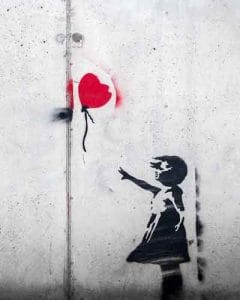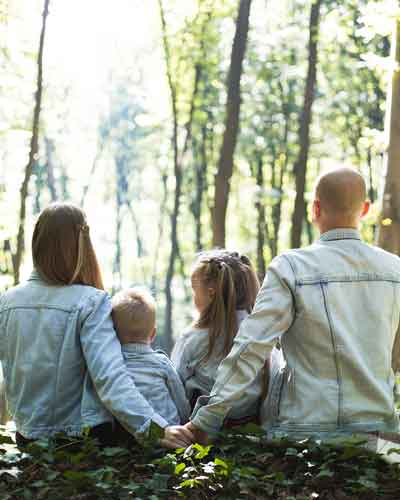
As part of the “25 Days” programme, where we awaken personal power, self-confidence and learn to set and achieve our chosen goals, we received an interesting question. A participant wanted to know how to deal with the painful feelings of losing a loved one or letting go of the past.
Since the response has been overwhelming among the people who have read it, we have decided to share it with you. (NOTE: some of the tips refer to the exercises in the “25 Days” workshop. You can access the tools available to everyone in the notes.)
Everyone lives in his or her own reality, which he or she has created, consciously or unconsciously, through a particular view of life. We have different priorities in life … we have different tolerances for things … we have different needs and desires that give us a sense of happiness and fulfilment … we are moved and affected by different things, and so on.
Although we share our world with others, we spend most of our lives alone with ourselves, with our thoughts and emotions.
The fact is that many of our views are inherited or “picked up” from our environment. In principle, children continue the patterns of their parents until they start to think for themselves, choose their own path or consciously change things they feel do not suit them.
Basic patterns of behaviour protect us as long as we are children. Later, when we are able to make sober choices for ourselves, they can be a major hindrance, because the mind wants to lump together many events – those that serve us and those that do not.
Therefore, one of the key actions that each of us needs to take is to re-examine the patterns and beliefs we have adopted. This is what the area of personal (or spiritual) growth is for – asking ourselves what we want out of life, checking where we are stuck, then removing the blockages and setting goals.
We are aware that our destination is not the final destination, but the feelings we awaken along the way… and which we can even strengthen and hold once we reach the destination.
The biggest obstacle is probably the extremes. Some teachings emphasise the resolution of the past; in the sense that only when we have resolved the blockages and unconscious patterns that shape our outlook on life and, consequently, our choices, can we embark on a new path.
Other teachings focus exclusively on achieving goals: if we decide and focus all our attention on a goal, we will concentrate so much energy on one point that blockages and patterns will dissolve.
The truth lies in between. If we have tried many times to achieve a goal and failed, no matter how hard we try, we will obviously not achieve much more with a new attempt. The same applies to resolving the past. If we have been “working on ourselves” for years or decades, trying to find happiness through discovering and removing our own shadows and blockages, and we are still not happy – then it is unlikely that removing yet another blockage (or a new technique) will get us there either.
In order to present the correct relationship between undoing unconscious blocks and patterns, resolving the past and setting goals, we have recorded an online event in which Boris Vene explains the eight-point process of loosening and resolving a trauma or block from the past.
You will find the video in the bonus content of the “25 Days” workshop. In addition to the video, you will also have an audio recording (which can be downloaded to your computer and further downloaded to MP3 devices) and a brochure with an extended description of all eight points and a complete example of how to put it into practice. [1]
This should be your first step. In addition, we suggest that you combine the past resolution technique with the exercises and meditations from the “25 Days” programme. [2]
The ultimate goal is not to resolve the past, but to live in the joy of the here and now

By taking the first step of resolving the past, you will be able to take the strong emotional charge out of unpleasant events and perhaps see the situation from a different angle. It is very difficult to move forward as long as we see the event only through the prism of pain and loss. We have all been there …
But don’t get caught in the loop – the purpose of the programme is not only to unshackle ourselves from the anchors of the past, but also to move forward. Reliving a tormenting past and dwelling on the background of an unpleasant event will not get you to your destination. On the contrary, the more you relive the difficult moments, the more you anchor them into yourself and they become more and more part of your personality and identity.
It is better to detach yourself a little from the situation. The worst question we can ask ourselves is: “Why did this happen to me?” Or: “Why is this happening to me?”
To answer such and similar questions, we would have to see the event from a completely different level, from a different time and place, and independently of our personal view of it.
Many situations come and go, but the aim is to acquire wisdom and move on, enriched by experience. Try to look at a painful situation not through a key critical moment (goodbye), but through all the years of joyful experience together.
Don’t deny the pain, but try to see the situation with less emotional charge: it came, it brought you something, and it left. But today is a new day, with many new potentials and beauties to tap into.
You can still be with your loved one in your thoughts all the time; just as you were connected to them for a time in their life when they were not physically there (for example, when they were physically absent for a long time; on a trip, say.) Even then, they were not there, but you were not sad.
You have proved to yourself that you don’t need her around for your own happiness. The problem is not with our current view of the situation, but with our thoughts about the future. In our minds, we are always looking to the future and wanting, in some way, to secure favourable conditions.
The time of mourning is a time of preparation for change, and many people do not make this decisive shift. Saying goodbye to a loved one is a big change and we cannot artificially create the previous situation or bring it back – the situation is over and now there is a new one.
You have the power to choose whether to live in the past in your mind, or to make joyful use of the moments available to you here and now.
How to live in the present and find joy, meaning and strength to carry on

Even today, you are surrounded by people who love, value and respect you. Try to turn your attention to them. After all, it is not the other person who brings you happiness. (The other person is only a catalyst for us to find pleasant feelings within ourselves.)
This means that by refocusing your attention, love, compassion… on a person you love, you can awaken in yourself similar feelings to those you had for the person who has gone.
It’s not easy, but it is possible. Through the meditations of joy (week 1 of the 25 Days programme) and gratitude (week 2 of the programme), find the key areas in your life that give you meaning, beauty, strength and inspiration to live each day anew.
Give your wholehearted and sincere attention to preparing for these two exercises. Try to find really joyful events and moments for which you are grateful.
Gratitude carries a very interesting charge – the experience of closure. For example, if we are grateful to a person for a gift, this brings closure to the experience: we have received the gift, we are grateful for it, and then there is a change – the enjoyment of the gift. (And we may be filled with thoughts of gratitude towards the person who gave us the gift.)
But this is a completely different energy from the desire for a new gift, or the desire to relive the same situation with the same person again.
In the meantime, help yourself with advice on resolving the past. [3]
But the key is the third week of the 25 Days programme, where we capture our power. You urgently need to develop an area that will occupy you strongly, take you over completely and through which you will be able to express your creativity.
The worst is when we have nothing to look forward to, or when no event can make up for a past experience. But this is the most important step, and it is really worth putting a lot of energy into finding joyful goals.
Think of all the things you have enjoyed or are still enjoying, the things you are good at, the things that made your heart race, etc. Find your youthful playfulness, exuberance, carefree, frolicsome… We all have it in us.
In short, awaken the child who is unburdened by the past and the future and set a goal around these energies. Or, as we say in the programme, a “project”.
Then let it take you over completely.
The best way to resolve unpleasant energies and feelings is to put another joyful and energetically powerful experience on the other side of the scale …. rather than “working on a painful experience”.
Recall the following comparison. When you find yourself in a raging river, your goal should not be to learn a swimming technique that will keep you in place … or a ground anchoring technique … or a free floating technique, etc. Your goal should be to reach the bank as quickly as possible.
When you step out of a raging river onto the bank, it’s all over. In your case, the symbolism of the riverbank is represented by a powerful, joyful experience that will suck you in. Focus your energy here. The more you surrender to this new situation, the more detached you will be able to look at the past… and the more quickly you will realise that life is beautiful today, even if it is not filled with the same people as in the past.
You will realise that individual experiences are special or different – but it is worth living for all of them. One experience opens the door to another… and if we don’t step through it, we are stuck in place, robbing ourselves of the miracle of life.
Only this way of looking at life will take you forward in the long term, towards joy and fulfilment.

Or, to put it another way, don’t look for a way to relive the past today. When we flirt with the past, we are simultaneously turning our heads away from this moment – which is the only moment available to us to co-create in it.
It is easy to fall into the trap of focusing on yesterday at the moment … and tomorrow we will focus on today … the day after tomorrow and so on.
And in doing so, we are missing out on all the beauty that lies ahead. So take a deep breath, look out the window and ask yourself how you can brighten your day. Fill it with things that make you happy. Call friends you appreciate and love, express your affection for someone who has gone out of their way for you, treat yourself to a little treat…
Remember, we experience what we express; not what others express towards us. We can only express what we first awaken in ourselves.
It all begins and ends with us.
PS: You have taken a very big step by signing up to the 25 Days programme and we are sure that it can help you considerably. Now, do your best to focus on yourself, on your potential and on all the beautiful, great and unique things you have to offer to yourself and to the world.
You have a lot to give, you just have to decide and close one chapter to open another.
All of us at 25 Days wish this for you with all our hearts and fingers crossed that you find the joyful, playful and strong side of your personality that will bring you back your zest for life, strengthen your will and make every day magical.
But you allow yourself to open your heart and look into your treasury.
[1] You can watch the video as part of the free videos on 25dni.si. After completing the four videos, sign up for the online event and you will be invited to watch this video about resolving the past.
[2] As part of the free video content on the 25dni.si website, you can watch the complete meditation. It is in the third video.
[3] If you have the book “The Big Ugly Crisis“, this is the area of the chapter “Resolving the Past.”
